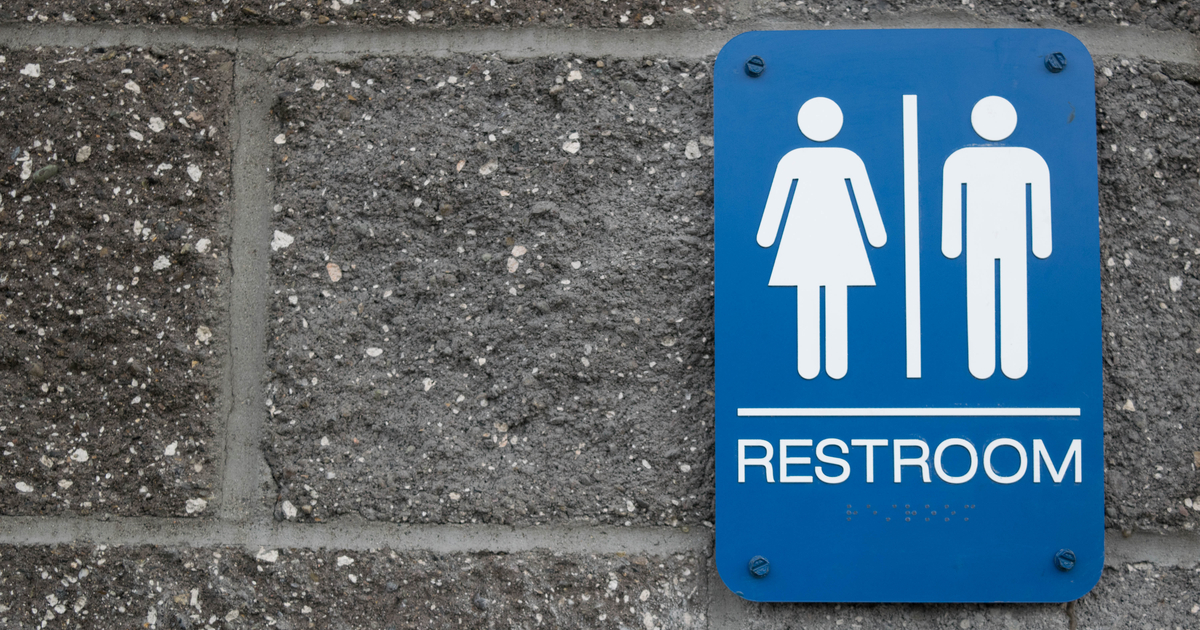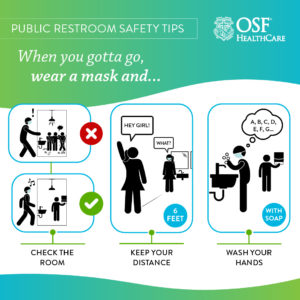
What you should know about public restrooms
Safety tip of the day for using public restrooms: Try to avoid them.
That advice is not just because of the COVID-19 pandemic.
“There is always an increased risk of cross contamination in public restrooms, which in turn can increase your risk of infection from a virus or bacteria,” said Pam Toppel, manager of Environmental Services for OSF HealthCare, Eastern Region.
“It does not appear the novel coronavirus is more prevalent than any other pathogen in that environment. Like other viruses and bacteria, it’s on surfaces – counters, handles, doorknobs. The biggest thing you can do to protect yourself is practice good hand hygiene.”
Actually, the best way to protect yourself is simply not to use a public restroom. But sometimes, there’s no choice. What then?
Pam suggests three basic steps: “Check the room. Maintain physical distance. Wash your hands.”
And, of course, wear a mask.
Check the room
Always be aware of your surroundings.
If you look inside the restroom and it’s crowded or dirty, move on – if you can. As we all know from experience, sometimes that’s not possible.
So avoid, or at least limit, direct contact with surfaces.
“There is no substantial data that indicates disease is transmitted from the seat to your bottom,” Pam said. “If using a seat liner or covering the seat with toilet paper increases your comfort level, go ahead. But understand, while doing so creates a barrier, it’s not impenetrable. Virus particles can get through, so it’s not 100% total protection.”
And don’t linger. You can find another mirror to comb your hair or fix your makeup.
Maintain physical distance
Whether the restroom is large or small, avoid the crowd. If you can’t maintain at least six feet between you and other patrons, wait outside.
“The line to use a stall doesn’t have to be inside. You can be the person to start the line outside,” Pam said.
“Naturally, if somebody is coughing, especially without a mask, back out. Looking back, pre-COVID, you didn’t know if the person coughing had tuberculosis. You didn’t know if they had the flu. Same thing now.”
Good hand hygiene
It’s what we were taught as children. It’s the mantra we’ve heard every day since the COVID-19 pandemic began.
Use lukewarm water. Rinse, lather, scrub for at least 20 seconds – sing “Happy Birthday To Me” twice if you’d rather not count – then rinse and dry with a paper towel. Use another paper towel to turn off the faucet. Throw those away, then grab one more paper towel to touch the door handle on the way out – and pitch that towel ASAP.
Pam adds one more caution with this step: Do not use blow dryers.
“Data shows they harbor bacteria,” she said. “People think hot air is OK, but some germs actually thrive in the heat, and the blowing air can help circulate them. Hand dryers are definitely not recommended. Personally, I don’t use them, even without the virus being a threat.”
If there are no paper towels, better to shake your hands dry. If you do use a blow dryer, use hand sanitizer immediately after leaving the room.
Put the lid down – if you can
Some studies indicate a potential threat when the toilet is flushed.
The novel coronavirus has been detected in fecal matter. Studies show flushing a toilet can expel a plume of droplets as high as two or three feet.
The best way to eliminate that risk is to close the lid on the toilet before flushing, but most public toilets don’t have lids. Still, Pam believes the flush risk is minimal.
“Toilets do aerosolize, but in my opinion, the droplets are bigger so they fall more quickly,” Pam said. “It’s not the same aerosolizing you would get with a sneeze or a cough, which hangs in the air longer.”
Use common sense
Here’s one more thing to keep in mind.
“Even if the restroom is empty, you never know what the person using it before you might have,” Pam said. “COVID-19 or not, you should always be on high alert. Common sense and the usual precautions go a long way to staying healthy.
“Physical distancing. Wear a mask. And good hand hygiene.”
